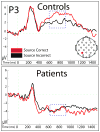Neurophysiological evidence for a recollection impairment in amnesia patients that leaves familiarity intact
- PMID: 22898646
- PMCID: PMC3483383
- DOI: 10.1016/j.neuropsychologia.2012.07.038
Neurophysiological evidence for a recollection impairment in amnesia patients that leaves familiarity intact
Abstract
In several previous behavioral studies, we have identified a group of amnestic patients that, behaviorally, appear to exhibit severe deficits in recollection with relative preservation of familiarity-based recognition. However, these studies have relied exclusively on behavioral measures, rather than direct measures of physiology. Event-related potentials (ERPs) have been used to identify putative neural correlates of familiarity- and recollection-based recognition memory, but little work has been done to determine the extent to which these ERP correlates are spared in patients with relatively specific memory disorders. ERP studies of recognition in healthy subjects have indicated that recollection and familiarity are related to a parietal old-new effect characterized as a late positive component (LPC) and an earlier mid-frontal old-new effect referred to as an 'FN400', respectively. Here, we sought to determine the extent to which the putative ERP correlates of recollection and familiarity are intact or impaired in these patients. We recorded ERPs in three amnestic patients and six age matched controls while they made item recognition and source recognition judgments. The current patients were able to discriminate between old and new items fairly well, but showed nearly chance-level performance at source recognition. Moreover, whereas control subjects exhibited ERP correlates of memory that have been linked to recollection and familiarity, the patients only exhibited the mid-frontal FN400 ERP effect related to familiarity-based recognition. The results show that recollection can be severely impaired in amnesia even when familiarity-related processing is relatively spared, and they also provide further evidence that ERPs can be used to distinguish between neural correlates of familiarity and recollection.
Published by Elsevier Ltd.
Figures







References
-
- Aggleton JP, Brown MW. Episodic memory, amnesia, and the hippocampal-anterior thalamic axis. Behavioral Brain Science. 1999;223:425–444. discussion 444–489. - PubMed
-
- Baddeley A, Vargha-Khadem F, Mishkin M. Preserved recognition in a case of developmental amnesia: implications for the acquisition of semantic memory? Journal of Cognitive Neuroscience. 2001;13(3):357–369. - PubMed
-
- Bell AJ, Sejnowski TJ. An information-maximization approach to blind separation and blind deconvolution. Neural Computation. 1995;7(6):1129–1159. - PubMed
Publication types
MeSH terms
Grants and funding
LinkOut - more resources
Full Text Sources

